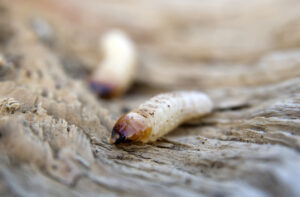
Need Help? Call Us On 0161 776 9832 For Expert Pest Control Advice On How To Identify Pest Infestations And Help Solve Your Pest Problem.
Wilmslow Woodworm Treatment Specialists
Three Types of Woodworm in the UK
Woodworm infestation is a problem in the whole of the UK. There are different types of woodworm, all with different preferences for living conditions. Here are three of the most common ones:
Common Furniture Beetle
The common furniture beetle measures approximately 2.7 to 4.5 mm in length. It has an ellipsoidal (rounded) body, which is brown in colour. This type of woodworm prefers softwoods to hardwoods. It bores into the wood and leaves exit holes slightly smaller than its body in size. Therefore, if you notice such holes on your timber, then you probably need Wilmslow woodworm treatment as soon as possible.
 The common furniture woodworm prefers damp areas to dry woods, which is why you are likely to find them in:
The common furniture woodworm prefers damp areas to dry woods, which is why you are likely to find them in:
• Damp loft timber
• Old furniture
• Damp floorboards
• Plywood
Therefore, if you have such items in your house, and you would like to keep them safe from woodworm damage, then you need Wilmslow woodworm removal treatment.
House Longhorn Beetle
The house longhorn beetles are identifiable by their shiny spots (the spots look like eyes, but they are not). They are brown or black in colour and tend to have hair on their bodies. These beetles are common in softwoods used for roof timbers, and they can wreak considerable damage to your roof. If you notice them in your roof structures, do not hesitate to call Young’s Pest Control for bespoke Wilmslow woodworm treatment options.
It is surprising that of all the common beetles in the UK, this is the only species that do not feed on wood in their adult stage. It is only their larvae that feed on wood, but you still need treatment for woodworm removal to prevent them from damaging your furniture. The adults lay their larvae in wood; they mature in the spring and then cut holes (around 6 to 10mm in diameter) to get out of the wood.
Deathwatch Beetle
 The deathwatch beetles, which measure approximately 7mm long, but their larvae can grow longer than the adults (up to 11mm long). Most people identify the deathwatch beetles by their characteristic ticking sounds, (others describe the sounds as tapping) in old rafters, especially during the summer. This is the sound they emit when they want to attract mating partners.
The deathwatch beetles, which measure approximately 7mm long, but their larvae can grow longer than the adults (up to 11mm long). Most people identify the deathwatch beetles by their characteristic ticking sounds, (others describe the sounds as tapping) in old rafters, especially during the summer. This is the sound they emit when they want to attract mating partners.
These beetles prefer hardwoods to softwoods, especially the ones that have been softened by decay. They also like very damp conditions, which is why you can find them in rotting wood. Once they attack wood in a damp area, they can mate and multiply very rapidly. They are one of the reasons woodworm infestation can develop very rapidly at times.
The worst thing about these beetles is that they prefer to tunnel the centre of the timber rather than its exterior. Thus, you might think that your pieces of wood furniture are safe while, in the real sense, their interiors have been extensively damaged. The only thing that can save you is Wilmslow woodworm treatment furniture solutions.
These are only three types of woodworm found in the UK. They can be very damaging to stored wood, furniture or even construction wood. Since most of them prefer damp areas, you should call for Wilmslow woodworm treatment furniture services (even as a precautionary measure) if you have some pieces of furniture that you have stored for a very long time.
SK9
